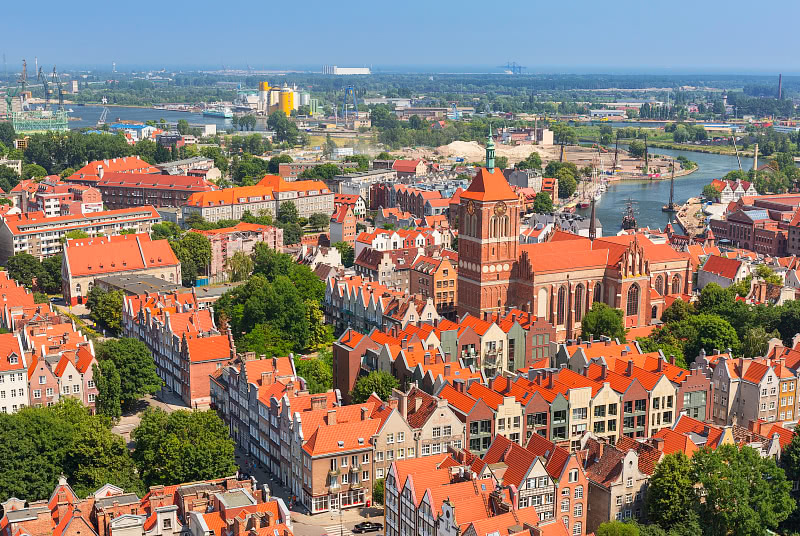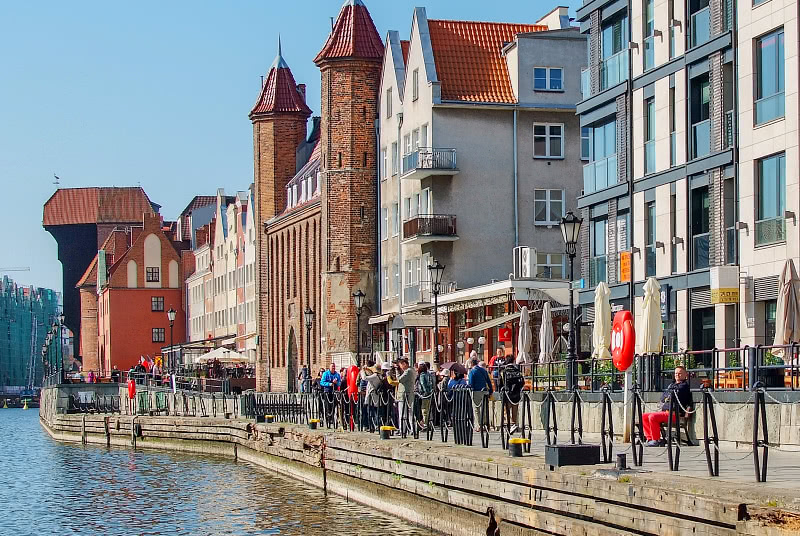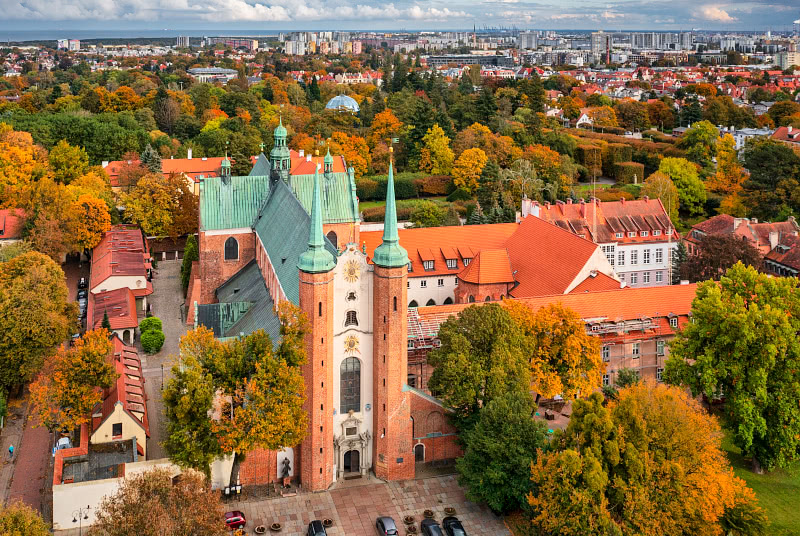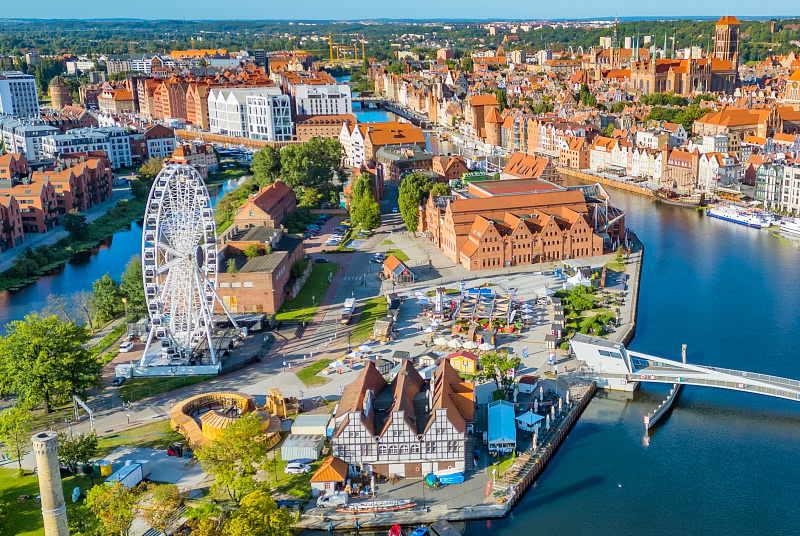Gdańsk Districts and Their Attractions

Gdańsk is a wonderfully compact and walkable city, even though it's actually quite large in terms of population. The heart of the city features a charming downtown area where you can explore Gdańsk's main attractions on foot. You won't have to worry about hunting down interesting spots scattered across a sprawling metropolis, the key sights are conveniently located within easy walking distance of each other.
Gdańsk, Sopot and Gdynia: The Tri-City
Gdańsk teams up with the nearby beach resort of Sopot [on map] and the port city of Gdynia [on map] to form what locals call the Tri-City.
During summer, you can hop on a train from Gdańsk to Sopot, it's just a quick 20-minute ride. The beaches in Sopot are absolutely worth the trip when the weather's nice, so definitely make time for this little excursion.
Gdynia used to have a reputation as a rather grim port city, but it's been seriously upping its game in recent years. These days, you'll find plenty of family-friendly attractions there too.
Street, Square and Plaza Names
In Gdańsk, street names consist of the actual street name preceded by the word "ulica," which means street. In everyday speech and on maps, "ulica" is often dropped, though it can be abbreviated to "ul." in official contexts. For example, the city's main street, ulica Długa [on map], is commonly just called Długa. It's pronounced "dvuga."
The word "targ" refers to a market square, and it's usually included both on maps and in official addresses. The exception is the city's main square, Długi Targ [on map] (Długa), which is often shortened to just Długi. However, if you're taking a taxi to Długi Targ, it's best to tell the driver "dvugi targ" to be clear.
For squares and plazas, you'll see the word "plac," which can be abbreviated to "pl." This word typically appears both on maps and in official contexts.

Central Gdańsk - Śródmieście
Śródmieście (literally "city center") is one of Gdańsk's main administrative districts, and it's divided into several smaller neighborhoods called osiedla.
The first area you'll want to know about is Główne miasto. This is where the real action is, Gdańsk's actual historic center, clustered around Długa Street. It's the beating heart of the city and where you'll find most of the must-see attractions.
Don't let the name Stare Miasto (Old Town) fool you. Despite what you might expect, this area is mostly modern shopping centers and former shipyard territory, not exactly the charming old town vibes the name suggests.
Stare Przedmieście, or the "Old Suburb," sits at the southern edge of Śródmieście. It might be small, but it packs a punch with some interesting spots worth checking out. Since it's compact, you can easily tack it onto your sightseeing route.

The Heart of Gdańsk, Główne Miasto
In Główne Miasto, the historic core of Gdańsk's city center, you'll find the best of what the city has to offer, stunning sights, fantastic restaurants, and great shopping. The area is now mostly car-free, so you can wander around at your leisure and really soak in the atmosphere. There's enough here to keep you busy for several days.
Why not start your exploration on Długa Street [on map] and continue to Długi Targ square [on map]. Along the way, you'll pass the Town Hall, one of the area's most impressive buildings. Walk through the Green Gate [on map] at the end of the square and you'll find yourself on the banks of the Motława River, where the Długie Pobrzeże promenade stretches out before you. Here you'll spot the Żuraw [on map], an old port crane that's become one of Gdańsk's most recognizable symbols and landmarks.
Make sure to check out Mariacka Street [on map], lined with old merchant houses and plenty of souvenir shops. At the end of the street stands St. Mary's Church [on map], the world's largest brick church. For more charming street views, explore Piwna [on map] and Chlebnicka streets [on map], which run parallel to Mariacka just a block away.
Old Town, Stare Miasto
Gdańsk's Old Town, or Stare Miasto [on map], stretches from the market hall area all the way to the former shipyard and the Solidarity Center. Despite its name, this part of town actually looks pretty modern these days, it's not quite the "old town" in the traditional sense that most people imagine. The main train station, Gdańsk Główny [on map], sits right on the edge of the Old Town, so if you're arriving by train, this is probably where you'll start exploring.
While the Old Town doesn't have quite as many attractions as Główne Miasto, its highlights are clustered around the Radunia Canal [on map]. Here you'll find the Great Mill and, facing it, the Small Mill, both once powered by the canal's flowing water. Across from the Great Mill stands Gdańsk's oldest church, St. Mary's Basilica (Bazylika Mariacka) [on map]. Tucked away behind it is another significant church, St. Bridget's (Kościół św. Brygidy) [on map], which was also the home church of strike leader Lech Wałęsa back in the 1980s.
Over in the shipyard area, Plac Solidarności [on map] still features the impressive monument to the shipyard workers. The famous Gate No. 2 remains intact, even though the shipyard itself has been cleared of its old industrial equipment. The area is now home to the European Solidarity Centre [on map], and about a 500-meter walk away you'll find Montownia Food Hall [on map], Gdańsk's largest food court, sprawling across nearly 3,000 square meters. Montownia houses over 20 different restaurants serving up flavors from around the globe.

The Old Suburb, Stare Przedmieście
Just beyond the edges of Gdańsk's medieval center, a few hundred meters south of Długa Street, you'll find Stare Przedmieście, the Old Suburb district. If you've got some extra time on your hands, this area is definitely worth exploring on foot.
Art lovers should make a beeline for the National Museum (Muzeum Narodowe w Gdańsku) [on map] (Toruńska 1), right in the heart of the old suburb. Here you can admire an impressive collection of paintings and antique artifacts. The museum is housed in a former Franciscan monastery, flanked by churches on both sides. The Holy Trinity Church [on map] (Świętej Trójcy 4) is particularly worth checking out.
Despite being relatively compact, Stare Przedmieście has a wonderfully laid-back vibe all year round. You'll find a handful of grocery stores scattered around, and even during peak season, the tourist crowds here are refreshingly thin compared to other parts of the city.

Ołowianka – An Island in the Heart of the City
Right across from the bustling Długie Pobrzeże waterfront promenade, you'll find Ołowianka island floating in the middle of the Motława River [on map]. You can hop over there either by catching a small ferry that crosses the river [on map] or by strolling across the Kładka przez Motławę footbridge [on map], which opened in 2017.
The island's classic must-see is the National Maritime Museum [on map] (Ołowianka 9-13), housed in three historic granaries. The exhibitions take you through Poland's maritime history from medieval times to today, featuring everything from ship models and harbor maps to underwater archaeological treasures. Right next door, you can't miss the SS Sołdek [on map] – Poland's first ocean-going vessel built after World War II. This red steamship now serves as a floating museum where you can explore the engine room and crew quarters.
Among the island's newer attractions, the AmberSky [on map] is a spectacular 50-meter-high Ferris wheel that's quickly become one of Ołowianka's biggest draws. From up there, you'll get stunning views of the city skyline and a truly unique perspective. The wheel features 36 climate-controlled, heated gondolas, each fitting about six people. There's even a VIP gondola decked out with leather seats, a fridge, and a TV screen.
Ołowianka has undergone quite a transformation recently, and you'll now find plenty of restaurants, cafés, and services. While winters are pretty quiet here, the island really comes alive in summer with various events like St. Dominic's Fair (Jarmark św. Dominika) and the Baltic Sail Gdańsk maritime festival. The island is also home to the Królewski Hotel [on map] (Ołowianka 1) and the Baltic Philharmonic concert hall [on map] (Ołowianka 1).